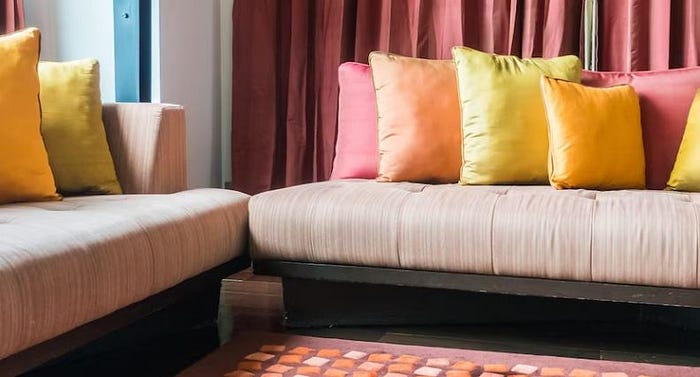Best Types Of Sofa Fabrics For Your Sofa

In interior design, furniture has a significant influence. A new sofa, for instance, can give your living area a completely new look and feel. However, it might be overwhelming to choose one that would be the ideal fit for your house with the wide variety of fabrics and design options available.
The fabric you select for your sofa counts just as much — if not more — than the size, shape, and cushion options. To assist you to make sure your sofa satisfies all of your comfort and practicality criteria, we’ll go over our top picks for the best sofa textiles in this article.
Cotton:
For several useful reasons, cotton, a natural textile, is a staple for sofas. First, cotton is among the most affordable alternatives available, which is always a bonus. Second, cotton is quite adaptable and takes both patterns and colors well. Cotton is available in a virtually infinite variety of hues and designs, from bright white to deep indigo, leopard print to cabana stripe. Also important if your sofa will be in direct sunlight is cotton’s resistance to fading.
Cotton has the drawback of being easily stained, therefore to keep your cotton sofa fabric looking new, we advise having it professionally treated before you bring it home. Alternately, use a complex design whose stain resistance stems from the fact that it is a skilled concealer.
Linen:
Compared to cotton, linen has a somewhat looser weave, giving it a distinctive texture that can be anything from silky and glossy to bulky and nubby. The hard thing with linen is that it can wrinkle and discolor very easily, just like linen clothing does. Performance linen is our preferred material for couches that must withstand heavy traffic because of this. Performance linen is a fantastic durable fabric choice for you if you have children, pets, or messy ice cream eaters in your home. Compared to conventional linen, it is a more structured fabric, so it maintains its shape while yet feeling soft and pleasant.
Slipcovers are frequently made of linen because it resists wear and tear without sacrificing style. It not only provides the utmost convenience of a quick wash, but it is also adaptable if you feel like experimenting or switching things up quickly with the seasons.
Velvet:
When touched, velvet feels luxurious, velvety, and wonderful. Silica absorbs color incredibly well, creating vivid hues that are both rich and distinctive. The drawback with pricey silk velvets is that, well, they are expensive and easily stained. We adore tight weave performance velvet, which withstands regular use and is perfect for velvet sofas in pretty much anyone’s home. To withstand fading, crushing, stains, and heavy traffic, pay close attention to velvets that are woven from cleanable, high-performance polyester. No headaches, all the tactile advantages.
Chenille:
Chenille, a close relative of velvet, has closed loops as opposed to an open nap. Chenille is chunkier than velvet, yet the fabric is still quite soft and velvety to the touch, adding to its durability. We advise looking for a performance chenille for stain resistance, just like with velvet. Owners of scratchy cats (or dogs!) should take caution because the tufted pile that makes up chenille is readily snagged by their claws.
Microfiber:
If you enjoy the way suede feels, microfiber is a great substitute fabric option that is both affordable and very stain-resistant. The one drawback is that it can be a magnet for hair and fur, so unless you enjoy lint-rolling your sofa many times per day, it’s not the best piece of furniture for houses with pets.
Also read: Things To Consider Before Selecting Your Sofa Fabric
Leather:
When it comes to luxurious fabrics, a leather sofa of great quality takes first place. There’s a good reason why leather is used nearly exclusively in some of the most recognizable furniture designs. Leather is elegant, strong, and stain-resistant. It is quite adaptable and may fit in just about any type of home, from ultra-modern to historic. Leather also ages nicely. It develops a beautiful patina with time, just like a cherished leather jacket, and becomes softer with each usage. Leather also resists allergens, which is advantageous if you or anyone in your household has allergies.
Despite this, leather is more expensive than cloth. This is something to think about if you have a tight budget (faux leather may be worth a look). It will cost significantly more to replace leather upholstery than cloth if you like to change your décor on a regular basis. A smaller selection of colors is also available in leather.
Useful Tip
For a true look-and-feel test to determine which sofa fabric finally prevails, order a variety of swatches. We advise that you test 4 to 6 swatches against your lifestyle and view them in various light sources throughout the day. Rub them on your bare skin or the back of your dog to make if the material lives up to your expectations for a sofa.
